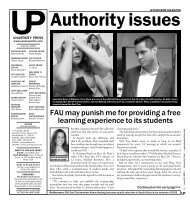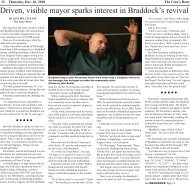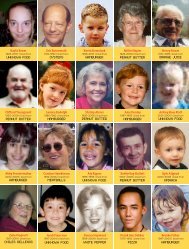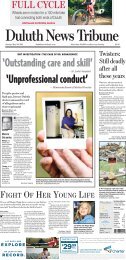THE YANKEE COMANDANTE
THE YANKEE COMANDANTE
THE YANKEE COMANDANTE
Create successful ePaper yourself
Turn your PDF publications into a flip-book with our unique Google optimized e-Paper software.
Cherne wanted to send someone to see<br />
him in the future, he should give that person<br />
the coin for presentation to Morgan—a<br />
sign of trustworthiness.<br />
After Cherne left the hotel, with the<br />
coin and the recording of their conversation<br />
tucked away, he grew anxious that he<br />
had been spied upon. Why had he taken<br />
such a foolish risk? Cherne scribbled on<br />
paper what he had learned, put it in an<br />
envelope, and slipped it to a trusted friend<br />
in Havana. “Just in case I didn’t get out,”<br />
he recalled.<br />
Cherne returned to his hotel and remained<br />
in his room. The phone rang, but<br />
he did not answer it. “I heard footsteps<br />
outside my door, and I sweated freely,” he<br />
recalled. Finally, he rushed to the airport,<br />
waited an “interminable period,” and<br />
“wasn’t relieved until the plane took off.”<br />
On March 20th, Cherne went to<br />
C.I.A. headquarters—then a complex of<br />
shabby buildings on E Street, in Northwest<br />
Washington, D.C. A sign saying<br />
“U.S. Government Printing Office” had<br />
once hung out front, but, after President<br />
Eisenhower and his driver struggled to<br />
find the entrance, it was replaced with the<br />
C.I.A.’s emblem.<br />
Cherne was ushered through security<br />
and into the French Room, a conference<br />
space used by senior C.I.A. officials,<br />
where he met with the acting chief of the<br />
Western Hemisphere Division. Cherne<br />
debriefed him about his encounter with<br />
Morgan, which he considered one of the<br />
“most incredible and fascinating accidental<br />
exposures to political reality in my entire<br />
life.” The C.I.A. cultivates its own<br />
private language, and Cherne, who was<br />
identified in a classified document about<br />
Morgan simply as “HQS contact,” was<br />
serving as a spotter—someone who<br />
identifies a potential asset for recruitment.<br />
Cherne told the C.I.A. that Morgan<br />
could be very valuable, as he was on<br />
excellent terms with Castro. And Cherne<br />
passed on Morgan’s coin—the kind of<br />
object that the magician Mulholland<br />
called a “recognition signal.”<br />
A C.I.A. report concluded that Morgan<br />
had “KUCAGE possibilities.” In his<br />
1975 book, “Inside the Company,” Philip<br />
Agee, a former C.I.A. officer who turned<br />
against the agency and allegedly assisted<br />
Castro’s regime, revealed that KUCAGE<br />
stood for highly sensitive psychological<br />
and paramilitary operations. “They are action<br />
rather than collection activities,” Agee<br />
wrote. “Collection operations should be<br />
invisible so that the target will be unaware<br />
of them. Action operations, on the other<br />
hand, always produce a visible effect. This,<br />
however, should never be attributable to<br />
the C.I.A. or to the U.S. government.”<br />
Not long after Castro took power, the<br />
C.I.A. began to seek out action operators<br />
who could press the “magic button”: assassination.<br />
In addition to commissioning<br />
Mulholland’s manuals, the C.I.A.<br />
had created a document titled “A Study<br />
of Assassination.” After noting that the<br />
“morally squeamish should not attempt<br />
it,” the study laid out various techniques:<br />
The most efficient accident . . . is a fall of<br />
75 feet or more onto a hard surface. Elevator<br />
shafts, stair wells, unscreened windows and<br />
bridges will serve....The act may be executed<br />
by sudden, vigorous [lifting] of the ankles,<br />
tipping the subject over the edge.<br />
If the subject is deliberately run down,<br />
very exact timing is necessary and investigation<br />
is likely to be thorough....The subject<br />
may be stunned or drugged and then placed<br />
in the car, but this is only reliable when the<br />
car can be run off a high cliff or into deep<br />
water without observation.<br />
At the end of March, the C.I.A. authorized<br />
a background investigation of<br />
Morgan—“a.k.a. ‘El Americano.’ ” Its<br />
<strong>THE</strong> OVERHAUL<br />
Look—it’s the Lively,<br />
hauled out above the tide line<br />
up on a trailer with two<br />
flat tires. What—<br />
fourteen-foot? Clinker-built<br />
and chained by the stern<br />
to a pile of granite blocks<br />
but with the bow<br />
still pointed westward<br />
down the long voe,<br />
down toward the ocean<br />
where the business is.<br />
Inland from the shore<br />
a road runs, for the crofts<br />
scattered on the hill<br />
where washing flaps,<br />
and the school bus calls<br />
and once a week or so<br />
the mobile library;<br />
but see how this<br />
agents needed more “biographical data”<br />
before trying to recruit Morgan. On<br />
March 30th, the agency’s Central Cover<br />
Division requested that it be advised<br />
immediately when Morgan had been<br />
“activated.”<br />
Two weeks later, Castro arrived in<br />
Washington, D.C., on what he billed as<br />
a “good will” tour. President Eisenhower<br />
declined to meet with him, but, when<br />
Castro appeared in public, wearing his<br />
rumpled green fatigues and empty pistol<br />
holster, he was cheered by Americans<br />
who saw him as a folk hero. “Viva Castro!”<br />
they shouted.<br />
Around this time, as Aran Shetterly,<br />
the biographer, recounts, another curious<br />
guest appeared at the Hotel Capri. He<br />
was a reputed bagman for the Mob<br />
named Frank Nelson. The Mob feared,<br />
correctly, that Castro planned to shutter<br />
its casinos and night clubs. (“We are not<br />
only disposed to deport the gangsters, but<br />
to shoot them,” Castro later proclaimed.)<br />
Nelson said that a friend in Miami<br />
was interested in Morgan’s “services.”<br />
“In my services?” Morgan asked,<br />
confused.<br />
It was Nelson’s turn to look around<br />
60 <strong>THE</strong> NEW YORKER, MAY 28, 2012









